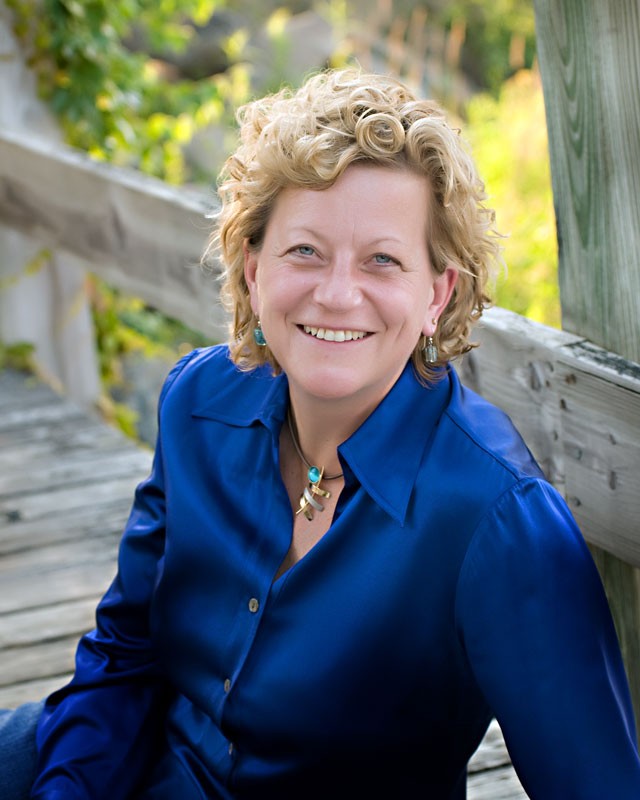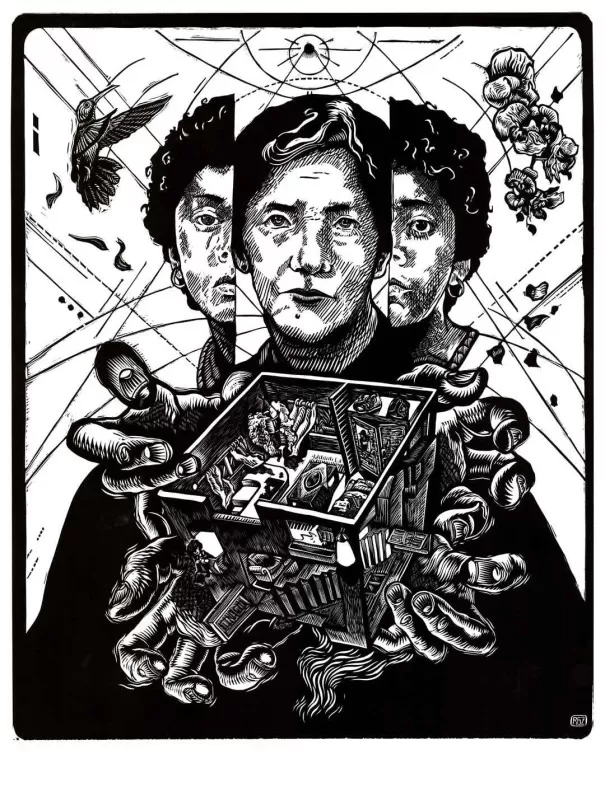Two years ago, Bernadette Popella and her husband, Hubertus, packed their bags and left Germany. After three decades as a licensed pharmacist and owner of a pharmacy in Hamburg, Bernadette had finally given up.
“I was always disappointed, because I found that I couldn’t really help people. I found myself … a slave of the pharmaceutical industry,” says Popella, through speech tinged with a German accent. “And I didn’t want that anymore.”
The Popellas are both licensed in Germany as holistic practitioners. They moved to the United States to pursue their passion of creating their own holistic remedies, which they make available at the Spokane Public Market. Though she is now pursuing her passion, Popella is still critical of the industry she participated in for so long.
“I would say 80 percent of all pharmaceutical remedies you don’t need,” says Popella. “They just swipe away the symptoms but not the cause of a disease.”
Popella outlines one of the many criticisms of mainstream medicine — that symptom alleviation is valued over taking time to solve what is at the root of the symptom in the fi rst place.
But some patients are finding solace in naturopathic medicine.
Naturopathic medicine is rooted in the belief that healing is an innate function of the human body. In other words, your body wants to make itself well. Another pillar of naturopathic medicine is the concept of knowing and treating the body as a whole, interconnected system, as opposed to a collection of disconnected parts. And while pharmaceutical drugs are sometimes used in naturopathic medicine, they are called upon only when no other option for treatment is available. Overall, the goal is always prevention.
The naturopathic approach requires a lot from doctors — especially time.
Dr. Laura Flanagan, who has been a naturopathic practitioner since 1998 and is on the board of directors for the Washington Association of Naturopathic Physicians, says that the first appointment with a new patient is usually well over an hour long. She covers everything from diet to sleep habits and then performs a physical exam. According to the American Association of Naturopathic Physicians, it’s not uncommon for a naturopathic doctor to even ask patients about their childhoods.
The idea is to get the most comprehensive picture of a patient possible. This quality time spent speaking with patients is a driving force behind naturopathic medicine.
“It’s a luxury to be able to spend that much time with patients. It helps me get to know them and understand what’s happening with them,” says Flanagan. “I feel like I can be a much better doctor when I understand how they digest their food, how they sleep at night, what the stressors are for them.”
Flanagan is, like most naturopathic doctors, a general practitioner. She sees a variety of patients at her lower-South Hill clinic — babies, the elderly, people suffering with anything from depression to fibromyalgia — and often works with their mainstream care providers, if they have them. But that’s not always the case.
“We actually see a lot of patients who have tried and failed with the conventional medical system,” says Flanagan. “They haven’t failed, but the medicine has failed them.”
Flanagan selects a course of treatment based on the specific needs of the patient. The focus is not on immediately banishing symptoms but using them as clues, or indicators of possible deeper problems. It’s more like detective work than anything — Flanagan gets to the bottom of the body’s warning signs using intensive interviews with the patient, analyzing tests and blood work, and calling on her medical knowledge.
“That gives me an idea of where the trouble spots might be, and how we can look at the body as a whole and really figure out the key thing that will help them get better,” says Flanagan.
And, she adds, Washington is one of the best places to be a patient of naturopathic medicine. Aside from the obvious long-term benefits of increasing overall health, patients also get breaks from insurance companies, whereas in other states, this type of care might not be covered.
“Our medicines are not expensive, our visits are not expensive, and we get people feeling well quickly,” says Flanagan.
The name Dr. Lise Alschuler rings a lot of bells in the naturopathic community. The former president of the American Association of Naturopathic Physicians, she was named one of Seattle’s best doctors by Seattle Magazine and has co-authored two books on naturopathic oncology, which is the treatment of cancer using naturopathic methods. She’s a pioneer in the field.
Alschuler sees naturopathic medicine getting a lot of flack from the mainstream.
“I think there are lot of misconceptions. I think one is that people might not understand the level of training that naturopathic doctors receive,” says Alschuler, who now focuses on naturopathic oncology in New Hampshire.
Like mainstream doctors, Alschuler says naturopathic doctors go through pre-med training, followed by an accredited four-year program at a naturopathic medical school (like Bastyr University in Seattle, where Alschuler has taught) and 4,100 hours of study. They must take the same science classes and study the same aspects of health and disease as do students at conventional medical schools. To become certifi ed, they must successfully complete a three-day licensing exam.
“Really, the only difference between that and conventional medical schools is the treatments we learn about. ... So it’s actually very rigorous training, and people may not realize that,” says Alschuler.
But just as mainstream medicine criticizes the naturopathic approach, Alschuler, like many others, has criticisms of her own.
“There’s a lot wrong with the system. No. 1 is that, in conventional medicine, there’s a lot of pressure on doctors to see a certain volume of patients and … there’s not a lot of incentive to spend time talking with their patients and provide them with lifestyle suggestions,” says Alschuler. “It’s really hard for a physician to make any money doing that.”
Alschuler adds that mainstream medicine focuses on these quick visits, on procedures and prescribing medications, and that’s missing the target.
“It’s very common for naturopathic doctors, when they’re seeing a new patient, to hear a story about how that patient got there,” says Alschuler. “And it usually is a story about not getting answers in conventional care, their symptoms just getting worse, getting frustrated trying to figure out who to go to.”
Though the numbers are pointing to a spike in the popularity of naturopathic medicine, naturopathic doctors still see their profession misconstrued.
“One of the misconceptions I see is that people think it’s lightweight, that it’s not real medicine, that you don’t go to a naturopathic doctor if you’re sick, that you just go to change your diet or whatever,” says Dr. Flanagan. “And that couldn’t be further from the truth.”
Naturopathic Therapies at a Glance
BOTANICAL MEDICINE: Use of substances derived from plants to treat a variety of illnesses.
ENVIRONMENTAL MEDICINE: Use of various therapies aimed at cleansing the body of contaminants found in our environment — like pesticides, synthetic hormones and food additives — in order to relieve symptoms of exposure.
FUNCTIONAL MEDICINE: Seeks to discover the root causes of a disease and analyze how they affect each individual’s body as a unique, interconnected system.
NUTRITIONAL MEDICINE: Draws a line between how a patient’s diet affects their overall health. This treatment includes identifying food sensitivities, nutritional deficiencies and problematic dietary habits.
LIFESTYLE COUNSELING: Analyzes the physical, mental and emotional elements of a patient’s life and how those elements impact the patient’s health. This treatment focuses on building the patient’s awareness of their environment and lifestyle.
HOMEOPATHY: Introduces patients to very small doses of a substance, which, in a larger dose, would produce symptoms of illness in a healthy person. An example would be using Apis, which is a dilution of bee venom and relieves symptoms of insect bites, to treat swollen and tender skin after a bee sting.
PHYSICAL MEDICINE: Covers a variety of treatments, like stretching and exercise, as well as hydrotherapy and “manipulation of the bones and soft tissue.”
PHARMACOLOGY: The prescribing of pharmaceuticals when necessary. With the exception of narcotics, naturopathic doctors in Washington State have full prescriptive rights.
Information courtesy of Dr. Laura Flanagan. Compiled by Tiffany Harms.
















